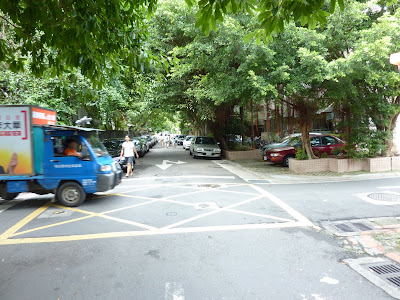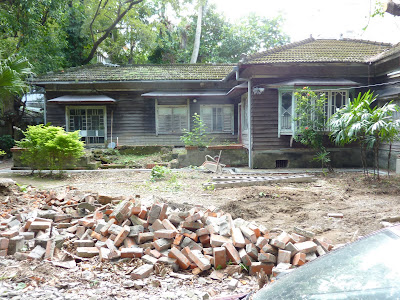Our walk to the temple takes about twelve minutes. Some days we do it several times. Monday, after I got there, I walked thirty minutes to the government building where I could pick up our ARC cards (Alien Residency Card). Our outside door opens onto Alley 10.
 At the next intersection, we turn right onto Qing Tian Street. This sign points to Lane 7. In the other direction, it is marked Lane 6.
At the next intersection, we turn right onto Qing Tian Street. This sign points to Lane 7. In the other direction, it is marked Lane 6. Qing Tian is a two-way street for cars, motor scooters, bicycles and pedestrians, although it is not much wider.
Qing Tian is a two-way street for cars, motor scooters, bicycles and pedestrians, although it is not much wider. The important thing to notice at this intersection is the round mirror on the blue light post. Most intersections have one, and they must be used a lot, the way they come buzzing through.
The important thing to notice at this intersection is the round mirror on the blue light post. Most intersections have one, and they must be used a lot, the way they come buzzing through. This is a nice, wide sidewalk on Qing Tian St, next to the Junior High School on the right (it only lasts one block).
This is a nice, wide sidewalk on Qing Tian St, next to the Junior High School on the right (it only lasts one block). Continuing, with the park on our left, we are on the only street on our way to the temple that has traffic lights and city buses. But in the next block there is no sidewalk and you have to walk in the street. So we don't go that way.
Continuing, with the park on our left, we are on the only street on our way to the temple that has traffic lights and city buses. But in the next block there is no sidewalk and you have to walk in the street. So we don't go that way. Instead, we turn right, cross the street with the light, and notice a street light post in the street. There are a lot of those.
Instead, we turn right, cross the street with the light, and notice a street light post in the street. There are a lot of those. Then left at the next corner. We like to walk the one-way streets, facing the traffic coming at us. Here we get shade from the tall buildings (when it's not raining).
Then left at the next corner. We like to walk the one-way streets, facing the traffic coming at us. Here we get shade from the tall buildings (when it's not raining). This is relatively wide. We've seen drivers maneuver their cars through narrow spaces with about one half inch to spare on each side.
This is relatively wide. We've seen drivers maneuver their cars through narrow spaces with about one half inch to spare on each side. This street would be wide enough for a car if there were nothing parked here. But that never happens, so only scooters and pedestrians pass.
This street would be wide enough for a car if there were nothing parked here. But that never happens, so only scooters and pedestrians pass. Across the intersection on the left, you can see a little bit of the Service Center and beyond that one spire of the temple (separate from the building and the top blends in with the cloudy sky).
Across the intersection on the left, you can see a little bit of the Service Center and beyond that one spire of the temple (separate from the building and the top blends in with the cloudy sky). Turning left, we are at the Service Center on our right. Actually, the Service Center only occupies the 4th floor with Public Affairs, Humanitarian Service, finance, translation, building design and maintenance (and such things). The 3rd floor is a complete meeting house with chapel, and the 1st floor is a complete meetinghouse, slightly larger, with chapel, gym, Relief Society room, primary, baptismal font and classrooms. Five wards meet in this building, and on the 2nd floor, three Stake Presidents have their offices, along with five bishops. In the basement is the Distribution Center.
Turning left, we are at the Service Center on our right. Actually, the Service Center only occupies the 4th floor with Public Affairs, Humanitarian Service, finance, translation, building design and maintenance (and such things). The 3rd floor is a complete meeting house with chapel, and the 1st floor is a complete meetinghouse, slightly larger, with chapel, gym, Relief Society room, primary, baptismal font and classrooms. Five wards meet in this building, and on the 2nd floor, three Stake Presidents have their offices, along with five bishops. In the basement is the Distribution Center. A lot of people come on scooters. It is affordable. I will have to take a picture of a family of four on one scooter.
A lot of people come on scooters. It is affordable. I will have to take a picture of a family of four on one scooter.




















































